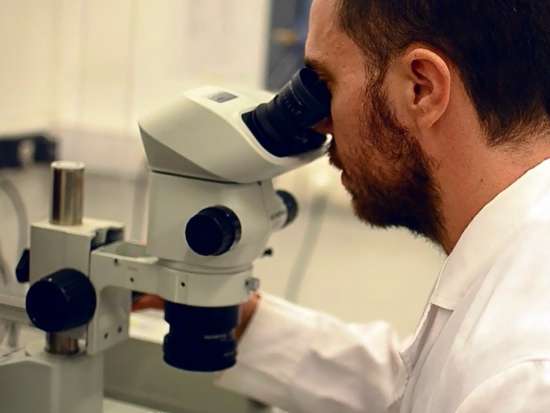First-ever observation of the native capside of a retrovirus

Researchers working at the Institut Pasteur in Montevideo (member of the Institut Pasteur International Network), in collaboration with the Uruguayan Medical School, obtained for the first time ever high-resolution images of the Bovine Leukemia Virus (BLV) capsid protein. Their images reveal unprecedented elements of flexibility in this protein, which are key for the assembly of the infectious particle. These findings, reported today in Science, represent a major progress in understanding retrovirus biology, opening new avenues towards the development of antiretroviral therapies.
Bovine leukemia virus (BLV) is an infectious disease that affects the immune system of cattle, causing immunodeficiency and in some cases triggering the development of leukemia or solid tumors in the form of lymphomas. This illness causes significant losses in productivity and even premature death of animals mostly in dairy farms. It also raises sanitary barriers for commerce of livestock and derived goods. As such, it has become a very prevalent veterinary issue, notably in Uruguay, which needs urgent solving. BLV is a virus highly similar to HTLV (which is the agent provoking human T cell leukemia), both also related to HIV. The latter is sadly famous for being the causative agent of AIDS. All these pathogens belong to a large group of viruses known as retroviruses. Luckily, BLV does not represent a threat for Human health, since it only infects B lymphocytes from cattle.
Getting to know in detail the properties of BLV can not only help to combat the disease in animals, but also lead to a better understanding of retroviruses in general. Retroviruses share many features about their life cycles and mechanisms of infection. Their genetic material consists of two RNA molecules, protected within a large protein structure that acts as a "shell", known as the virus capsid. This capsid is formed by hundreds of copies of a single protein encoded by the viral RNA, which has the amazing capacity of self-assembling when the virus needs to build new particles. Once the retrovirus invades a cell of the infected host, the capsid disassembles, uncoating the genetic material for it to be ready to go inside the nucleus, inserting itself as DNA into the cell's chromosomes. The infectivity of the virus depends upon the ability of the capsid to assemble and disassemble at the right times. Consequently, it is key to study its structural organization in detail.
The researchers at the Institut Pasteur in Montevideo, in collaboration with the Uruguayan medical School, have now revealed that the retroviral capsid is very flexible. Moreover, specific regions of the protein were observed to be determinant, playing a key role in mediating such plasticity. Thanks to this novel view, unexplored avenues open up towards the design of new antiviral medicines, which could be used in the future to cure bovine leukemia or yet other diseases caused by retroviruses.
The important findings that are now being reported have been made possible thanks to the observation of the three-dimensional structure of the capsid of the BLV virus at high resolution, actually achieving near atomic detail. Using a technique called X ray diffraction, scientists were able to determine the molecular structure by accurately defining where each atom of the protein is located in 3D space. Most importantly, the capsid was studied without suffering any modification or protein engineering.
A few years ago, to achieve this kind of images, scientists had to introduce several mutations in a HIV capsid to make the protein more rigid, thereby affecting the scientific observation of its natural state. X ray diffraction of biological molecules in the crystal state is one of the most powerful methods to unravel their shapes and properties, reaching unimaginable levels of detail.
At the Institut Pasteur in Montevideo, the BLV virus protein was highly purified and crystallized. These crystals consist of hexagonal assemblies of the protein, resembling a honeycomb. This is exactly how the protein arranges itself in the viral particles in real life, hence the relevance of the observations.
Alejandro Buschiazzo, last-author of this article, points out that "these discoveries not only contribute with a deeper understanding of the biology of retroviruses. They also represent a milestone for the science carried out at Institut Pasteur in Montevideo, within the Uruguyan scientific community as a whole."
He finally emphasizes that this publication "proves how important it is to train our students in cutting edge molecular techniques, focused on relevant problems for our societies. We take this achievement as the beginning of stronger collaborations with colleagues worldwide: science is a global endeavor, to understand more about Biology, and to tackle with increasing success the health problems that affect us".
More information: Conformational plasticity of a native retroviral capsid revealed by x-ray crystallography, Science, 4 June 2015. DOI: 10.1126/science.aaa5182
Journal information: Science
Provided by Institut Pasteur de Montevideo




















